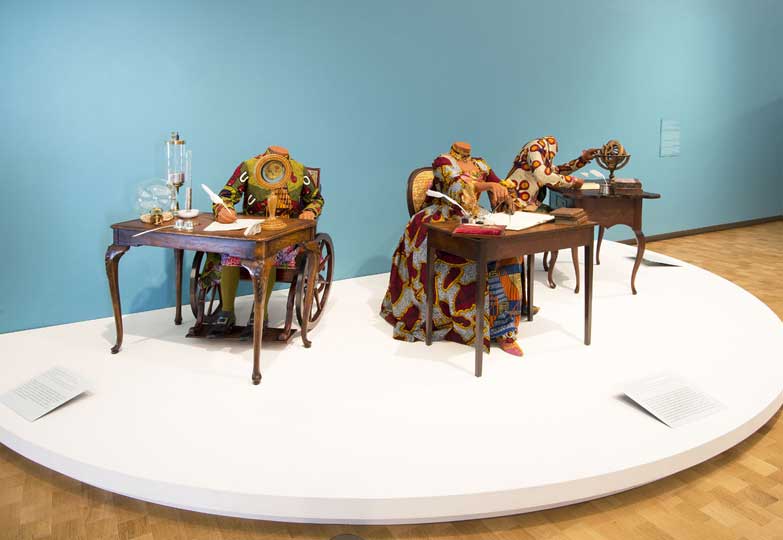Curators grow attached to the work of the artists they get to collaborate with. So as I visited ‘Yinka Shonibare MBE : Magic Ladders’ at the Barnes Foundation a mere two weeks after the artist’s show at Royal Museums Greenwich ended, it felt like visiting friends. Stepping into the galleries, I could not repress a smile: dressed in Shonibare’s signature ‘Dutch wax’ fabric, an eccentric lady on stilts, a raffish dandy, lively little boys and girls, studious thinkers and arguing diplomats inhabit the space. All that is missing here is the sound of boisterous laughter and animated conversation. Or is it? For the visitors certainly are being given much to talk about.
Magic Ladders (detail; 2013), Yinka Shonibare MBE. Commissioned by the Barnes Foundation, supported by The Pew Center for Arts & Heritage. London. Photo: Stephen White

There are fascinating similarities between Albert C. Barnes (1872–1951) and Yinka Shonibare (b. 1962), notably a shared interest in education, social mobility, scientific and cultural discovery. Both challenge eurocentrism in art, and Shonibare’s merging of fine and decorative arts may recall Barnes’ distinctive display choices, hanging, for instance, post-Impressionist masterpieces alongside wrought iron.
Unlike Barnes, however, Shonibare lives in a postcolonial age of globalisation, and his work explores cultural identity and authenticity in multilayered and thought-provoking ways. With this new show, rather than engaging with the buildings and art collection as he did at Greenwich, Shonibare reflects on Barnes’ personality and the origins of his Foundation, set up in 1922 to ‘promote the advancement of education and the appreciation of the fine arts’.
‘Planets in my Head’ (Philosophy), (2011), and ‘The Sleep of Reason Produces Monsters (Asia), (Australia), (America)’ (2008). Photo: Rick Echelmeyer

The exhibition is named after Shonibare’s latest series of works, Magic Ladders (2013), the Foundation’s first commission from a contemporary artist since Matisse’s Dance II mural in 1932. These make a moving tribute to Barnes’ mission: children are seen playfully climbing ladders, the rungs of which are made out of books referencing Barnes’ own library.
Barnes encouraged his factory’s employees to study psychology, philosophy and art during their working day. Advancement through knowledge, Barnes and Shonibare tell us, is no longer the exclusive pursuit of the elite. By way of contrast, Shonibare’s Age of Enlightenment figures (2008) – among them Antoine Lavoisier, like Barnes a chemist – bear imagined disabilities evoking human frailties that reason cannot overcome. Headless, they also bring to mind the beheadings of the French Revolution, while The Sleep of Reason Produces Monsters – a group of photographic tableaux from 2008 – is inspired by Goya.
The Age of Enlightenment—Antoine Lavoisier,—Gabrielle Émilie Le Tonnelier de Breteuil, marquise du Châtelet ,—Immanuel Kant (installation view; 2008), Yinka Shonibare MBE. Hirshhorn Museum and Sculpture Garden, Smithsonian Institution, Washington DC, Laura Lee Brown and Steve Wilson, 21c Museum, Louisville, Kentucky and Jim Gray, Lexington, Kentucky, Milwaukee Art Museum. Photo: Rick Echelmeyer

Other works in the exhibition cast a more critical eye on Barnes. In their new setting, Scramble for Africa (2003) invites us to consider Barnes’ collecting of African art in the context of colonialism, while Victorian Philanthropist Parlour (1996–97) can be read as both a homage and a parody of Barnes’ collecting habits. Covered in ‘Dutch wax’, the mimicked period room evokes the self-made man, the painstaking arrangement of the objects amassed by the collector, but also questions the nature of philanthropy, which, in the colonial context, Shonibare says, is ‘a condescending idea where the power relationship is never equal’.
Victorian Philanthropist’s Parlour (1996–7), Yinka Shonibare MBE. Courtesy of the artist; Edward Tyler Nahem, New York, JCG5658.

‘Yinka Shonibare MBE at Greenwich’ allowed us to look at the collections at Royal Museums Greenwich, and the stories they tell, with fresh eyes, and one gets a sense that something similar is achieved at the Barnes Foundation. With his colourful wit, critical thinking and subversive perspective, Shonibare celebrates and probes Barnes’ approach to art and education, injecting a healthy dose of self-questioning to the institution.
The contemporaneity of the issues Shonibare interrogates gives the mission of the Foundation a renewed sense of urgency: his founder wanted his collection to edify the public, and with such striking contemporary art shows, it very much continues to do so.
‘Yinka Shonibare MBE: Magic Ladders’ is at the Barnes Foundation, Philadelphia, until 21 April.
All works by Yinka Shonibare MBE, © Yinka Shonibare MBE. Images courtesy James Cohan Gallery, New York/Shanghai and Stephen Friedman Gallery, London.
Related Articles:
Culture Clash at the Royal Museums Greenwich (Miranda Stearn)



